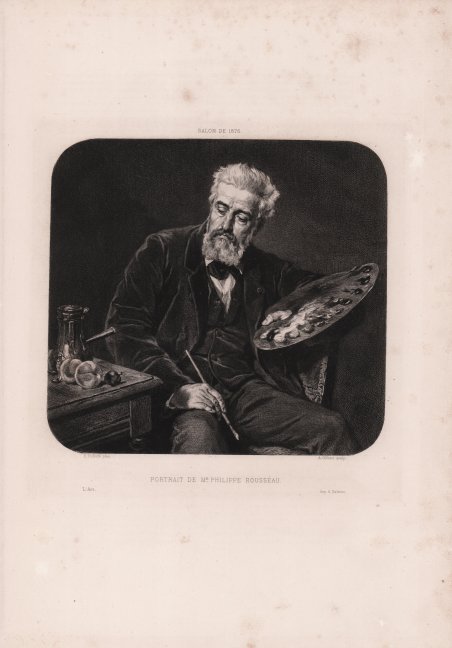Ritratto di Philippe Rousseau, raffigurato di tre quarti, seduto con una tavolozza nella mano sinistra e un pennello nell'altra, mentre guarda un vaso e alcuni frutti su un tavolo a sinistra. Acquaforte, 1877, firmata in basso. Scritta sopra l'immagine: "Salon de 1876" e sotto con i dettagli della produzione: "E. Dubufe pinx.", "A. Gilbert sculp." e "Imp. A. Salmon". L’incisione deriva dal celebre dipinto che Eduard Dubufe espose al Salon del 1876, oggi conservato al Musée d'Orsay. https://www.musee-orsay.fr/it/opere/philippe-rousseau-16968 Philippe Rousseau (Parigi, 1816 – Acquigny, 1887) è stato un pittore francese. Allievo di Gros e di Bertin, si dedicò inizialmente al paesaggio, dipingendo dal vero e insieme ispirandosi agli olandesi del XVII secolo. L’influsso di questi ultimi impronta altrettanto profondamente le sue rappresentazioni di animali; sue opere rappresentative si trovano nei musei di Chartres, Douai, Lione, Riom, Rouen. Le nature morte, che costituiscono la parte migliore del suo lavoro, come ad esempio Marmellate di prugne, del 1871, ora al Musée di Dieppe e altri esempi al Museo del Louvre di Parigi, alla National Gallery di Londra, allo Stedelijk Museum di Amsterdam e nei musei di Le Mans, Reims e Valenciennes. Bellissima impressione, su carta vergata coeva, con ampi margini, ottimo stato di conservazione. Bibliografia IFF, Inventaire du Fonds Français: Bibliothèque Nationale, Département des Estampes (51). Portrait of Philippe Rousseau, after Dubufe; three-quarter length, seated with a palette in his left hand and a brush in the other, looking at a pot and some fruits on a table at left; from "L'Art". 1877 Etching, 1877, lettered above image: "Salon de 1876" and below with plate title, publication title, and production detail: "E. Dubufe pinx.", "A. Gilbert sculp." and "Imp. A. Salmon". The engraving is derived from the famous painting that Eduard Dubufe exhibited at the 1876 Salon, now preserved at the Musée d'Orsay. https://www.musee-orsay.fr/it/opere/philippe-rousseau-16968 Philippe Rousseau (Paris, 1816 - Acquigny, 1887) was a French painter. A pupil of Gros and Bertin, he initially devoted himself to landscapes, painting from life and at the same time drawing inspiration from the 17th-century Dutch. The influence of the latter equally deeply imprinted his depictions of animals; his representative works are found in the museums of Chartres, Douai, Lyon, Riom, and Rouen. Still lifes, which constitute the best part of his work, such as Plum Jams, 1871, now in the Musée de Dieppe and other examples in the Louvre Museum in Paris, the National Gallery in London, the Stedelijk Museum in Amsterdam, and the museums of Le Mans, Reims, and Valenciennes. Beautiful impression, on contemporary laid paper, with wide margins, very good condition. A very good impression, on contemporary laid paper, with wide margins, very good condition. Bibliografia IFF, Inventaire du Fonds Français: Bibliothèque Nationale, Département des Estampes (51). Cfr.

Scopri come utilizzare
Scopri come utilizzare

